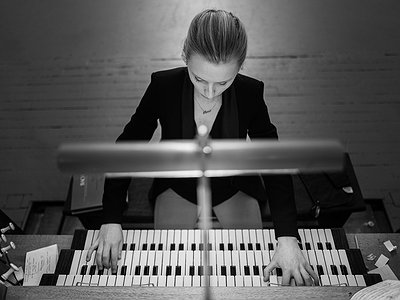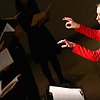Name: Anna Lapwood
Occupation: Organist, conductor, broadcaster, director of music at Pembroke College
Nationality: British
Current release: Anna Lapwood releases her solo album Images on Signum Classics on 3rd September. She performs at the BBC Proms on 7th September.
Recommendations: I’m currently reading Sara Maitland’s ‘A book of silence’ which I’m finding really rewarding. She talks about the cultural history of silence and her own personal journey with it. I think I’m finding it particularly interesting after the past year and a half, having lived by myself and spend quite a lot of time in a state of relative silence!
My current favourite artist is the Estonian painter Jaanika Talts, and I adore her ‘Vide cor Meum’. I love the depth of colour in this painting and the fact that the texture is so clear you feel as if you can reach out and touch it.
If you enjoyed reading this interview with Anna Lapwood and would like to find out more about her work, visit her official homepage for further information. She is also on him on Instagram, Facebook and Twitter.
When did you start playing your instrument, and what or who were your early passions and influences? What was it about music and/or sound that drew you to it?
I came to the organ comparatively late in my mid-teens, having spent several years playing every instrument I could get my hands on! When I was growing up I loved seeing how the technique of one instrument could translate onto another but create a different auditory experience, and how the same piece could gain a new meaning when played on a different instrument. I guess the organ satisfies this fascination as we get to replicate so many different sounds!
I found the organ really difficult in the early days and I think it was this challenge that made me determined to take it further. I loved the fact that it engaged the whole body, using your feet to create musical lines as well as just your hands, and I adored the fact that every organ was slightly different so there was so much opportunity for experimentation and discovery.
For most artists, originality is preceded by a phase of learning and, often, emulating others. What was this like for you: How would you describe your own development as an artist and the transition towards your own voice?
I don’t think we ever really stop learning as musicians – I’m always discovering new ways to think about certain pieces or aspects of technique, whether that’s through watching other musicians, collaborating with friends and colleagues, or just having a conversation in the pub.
Emulating others is an interesting one. I often hear recordings that introduce me to new ideas and think ‘I want to try that’, and then as an artist you choose which ideas to keep and which to discard. In that sense, I think our voices are always going to be a bit of a patchwork.
I also think it’s important to recognise that our voices are constantly changing – we don’t hit 25 and then have a fixed identity and voice that stays with us for the rest of our career! That’s one of the reasons recording is so interesting – it’s a snapshot of how you feel about that music at a certain point in your life. I’m sure I’ll look back on Images in a couple of years and have changed my mind about all sorts of things. I guess in a way it’s a bit like learning to speak – when we’re first learning words, we learn through copying. We then reach a point where we basically know how to speak, but that doesn’t mean we don’t continually acquire new vocabulary, or suddenly realise we’ve been pronouncing something wrong our entire lives …!
How do you feel your sense of identity influences your creativity?
I had a relatively recent revelation that it’s impossible to be creative and properly express your musical thoughts if you’re trying to be someone you’re not. Lockdown has been tough in many ways, but I think it has given a lot of us some much-needed time and space for self-reflection, and the opportunity to think more carefully about our sense of identity.
This manifests itself slightly more obviously for me when I think about conducting: when I first started out as a choral conductor I found myself performing a very male role. I would speak lower, I cut my hair short, and I always wore blazers and trousers. It’s only in the past 5 years or so, as I’ve become more comfortable with being myself on the podium, that I'm allowing myself to be vulnerable and as a result having musical experiences that are far more meaningful and profound.
What were some of your main challenges when starting out as an artist and in which way have they changed over the years?
One of the big challenges I’ve encountered surrounds the idea of a portfolio career. From a very young age I enjoyed breadth as opposed to intense study of one instrument, and, from a very young age I was told that was not the way to go if I wanted to be a successful musician! I remember being told that I couldn’t take up the harp as I already played three instruments and there was no way I could achieve good results on four.
This attitude pervades into professional life, too. On numerous occasions people have tried to encourage me to focus on just one thing – JUST be an organist, JUST be a conductor, or JUST be a broadcaster – in many ways I think it would be easier! But I adore variety, and I love how all the different strands interact – I genuinely couldn’t choose one over the others.
As creative goals and technical abilities change, so does the need for different tools of expression. Can you describe this path for you, starting from your first instrument?
This is an interesting question when it comes to the organ as all organs are so different! The organ I played on when I was starting out was a very small instrument – just two manuals (keyboards) and only a small number of stops. I will never forget the first time I went to a large instrument – I felt completely lost! It felt a little like I had learnt to ride a bike and it was therefore assumed I could also drive a car, if that makes sense. For a long time I was rather nervous about larger, modern organs for this reason, favouring small instruments well-suited to Baroque repertoire.
That has all changed in the last 4/5 years as I’ve spent much more time with large symphonic instruments. It’s so exciting playing with different combinations of sound and having such an extreme expressive range at your fingertips. Falling in love with these instruments has also run alongside falling in love with playing orchestral transcriptions. I always adored playing in orchestras as a harpist (although I didn’t enjoy having to count hundreds of bars rest before each entry!), so being able to play all the same repertoire by myself is a real joy.
Tell me about your instrument, please. How would you describe the relationship with it? What are its most important qualities and how do they influence the musical results, including your own performance?
I guess this ties in with my previous answer. Every instrument is completely different, and so as organists we are constantly tweaking our interpretations to fit a certain organ and a certain building. This can involve altering the speed to match the size of acoustic, incorporating subtly different sounds depending on the organ stops available, or, as happened to me recently, having to move whole sections down the octave because the organ didn’t have the note I needed at the top!
Whereas instruments such as pianos are standardised and you always know you will have the same number of notes at your disposal, on the organ it is much more variable and so some music is just completely incompatible with certain instruments. It certainly keeps us on our toes (pardon the pun) …!
How would you describe your approach to interpretation? Where do you start and how do you develop your view on a piece, what are some of your principles and what constitutes a successful interpretation for you?
I’m trying to get better at seeing interpretation as something flexible instead of fixed. A piece will mean something quite different depending on what else has happened that week, the sort of space I’m in, what other pieces I’m playing alongside it, and the instrument I’m playing.
When I’m first getting to grips with a piece, I tend to avoid listening to recordings until I already have a good grasp of the notes. At that point I try to listen to as many different recordings as possible and do some reading about the genesis of the music and its social context. I then use that knowledge to inform my musical decisions, even if the decision is to ignore that particular bit of information. I try to also think through the spectrum of desired emotional impact of the piece, both on myself and on the audience.
For me, a successful interpretation is, first and foremost, one that has had an emotional impact on the audience and makes them feel something. I find this easier with some pieces of music than others!
Collaborations can take on many forms. What role do they play in your approach and what are your preferred ways of engaging with other creatives?
I adore collaborating with other musicians – I think we can learn so much from working alongside other instrumentalists. Playing the organ can be quite a lonely endeavour as we spend quite a bit of time in organ lofts by ourselves, so being able to share that experience with other musicians is something I always seek out!
A couple of years ago I played the Bach organ trio sonatas as duets with a recorder player, and it completely transformed my thinking about them. We would pass little bits of ornamentation between our parts, making little musical jokes in our performances, and it helped me really think about it as chamber music instead of just a technical exercise.
I’ve particularly enjoyed doing more orchestral work recently – playing Poulenc’s Organ Concerto with the London Chamber Orchestra felt like large-scale chamber music and gave me a really amazing buzz that I hadn’t experienced for quite some time. I found the process of reconciling our interpretations fascinating – the conductor, Chloé van Soeterstède, was amazing at sharing ideas and being open to discussion about interpretation. She was also great at thinking about the impact of the building and adjusting aspects of tempo and articulation accordingly.



